Navigation
Singapore's NEWater Wins UN-Water Award On World Water Day
NEWater’s comprehensive public communications and education program was recognized by UN-Water for building public confidence and acceptance in NEWater, Singapore’s own brand of recycled water which comes from collected and cleaned wastewater.
_edited-1.jpg) Singapore Home of NEWater: Photograph by Erwin Soo from Singapore courtesy of Wikipedia
Singapore Home of NEWater: Photograph by Erwin Soo from Singapore courtesy of Wikipedia
NEWater’s comprehensive public communications and education program was recognized by UN-Water for building public confidence and acceptance in NEWater, Singapore’s own brand of recycled water which comes from collected and cleaned wastewater.
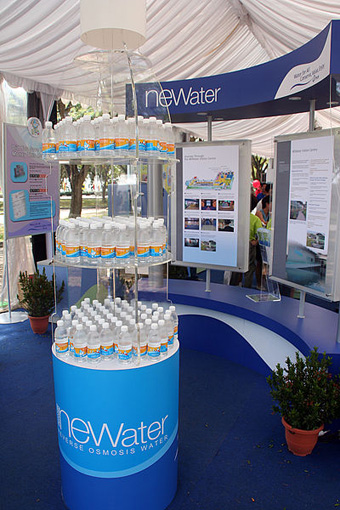 Bottles of NEWater for distribution at a public exhibition during the National Day Parade celebrations: Marina South, Singapore in 2005 Photograph by Huaiwei courtesy of WikipediaIn Singapore, over the last 25 years the rivers and streams have been cleaned, the sewer system advanced to reach 100 % of the population, and a NEWater program which effectively collects and cleans wastewater –surpassing international drinking water standards, implemented. Singapore will ramp up its NEWater and desalination capacity such that by 2060 they will account for 80 per cent of Singapore's water demand.
Bottles of NEWater for distribution at a public exhibition during the National Day Parade celebrations: Marina South, Singapore in 2005 Photograph by Huaiwei courtesy of WikipediaIn Singapore, over the last 25 years the rivers and streams have been cleaned, the sewer system advanced to reach 100 % of the population, and a NEWater program which effectively collects and cleans wastewater –surpassing international drinking water standards, implemented. Singapore will ramp up its NEWater and desalination capacity such that by 2060 they will account for 80 per cent of Singapore's water demand.
NEWater, Singapore’s own brand of recycled water has won the ‘Water for Life’ United Nations Water (UN-Water) Best Practices Award 2014 for its public communications and education efforts.
Conferred annually by UN-Water, the award aims to promote efforts to fulfill international commitments made on water and water-related issues by 2015 through recognition of outstanding best practices that can ensure the long-term sustainable management of water resources.
NEWater was awarded the prize under the “Best participatory, communication, awareness-raising and education practices” category.
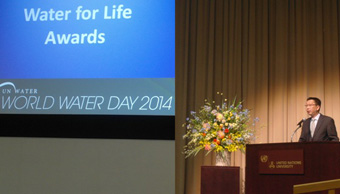 PUB Chief Executive Chew Men Leong giving an acceptance speech at the ‘Water for Life’ United Nations Water (UN-Water): Best Practices Award 2014 in Tokyo, Japan. Photograph courtesy of United Nations Water (UN-Water).Public Utilities Board (PUB) Chief Executive Chew Men Leong received the award during a special ceremony held in commemoration of World Water Day 2014 in Tokyo, Japan on March 22, 2014.
PUB Chief Executive Chew Men Leong giving an acceptance speech at the ‘Water for Life’ United Nations Water (UN-Water): Best Practices Award 2014 in Tokyo, Japan. Photograph courtesy of United Nations Water (UN-Water).Public Utilities Board (PUB) Chief Executive Chew Men Leong received the award during a special ceremony held in commemoration of World Water Day 2014 in Tokyo, Japan on March 22, 2014.
“The Jury of the 'Water for Life' UN-Water Best Practices Award has recognized NEWater for its strong social component and enduring partnerships in its manifold and remarkable water management practices contributing to Singapore’s water sustainability,” said Ms. Josefina Maestu, Director of UN-Water Decade Programme on Advocacy and Communication.
A key pillar of Singapore’s water sustainability strategy, NEWater is one of the four sources of water under the ‘Four National Taps’ strategy for securing water, which also includes local catchment water, imported water and desalinated water.
Singapore’s National Water Agency:
Public Utilities Board (PUB): The Singapore Water Story
Sustainable water management
To ensure consistent production of pure water, a new grade of water was created. NEWater is the brand name given to the reclaimed water produced by Singapore's Public Utilities Board (PUB). Together with PUB, Siemens created a sustainable water resource management solution which benefits industries and communities alike. The process consists of membrane pre-treatment, reverse osmosis and UV light disinfection to produce high quality drinking water. Using the Siemens Memcor Membrane technology for the pre-treatment process, the plant now produces over 80,000 m3 of NEWater per day.
This video was Uploaded on YouTube on Aug 26, 2010.
Pioneered by PUB, Singapore’s national water agency in 2003, NEWater is ultra-clean, high-grade reclaimed water produced from treated used water using advanced membrane technologies. It has passed more than 100,000 scientific tests and exceeds the drinking water standards set by the World Health Organization and the United States Environmental Protection Agency.
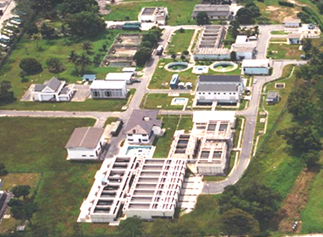 With the commissioning of the Ulu Pandan NEWater plant on 15 March 2007,: Industrial Water customers in Jurong and Tuas have since switched to using NEWater. Industrial Water is now only supplied to Jurong Island. Photograph and text courtesy of PUB.Used primarily for non-potable purposes at wafer fabrication parks, industrial estates and commercial buildings, a small amount is also blended with raw reservoir water before undergoing treatment at the waterworks for the water supply.
With the commissioning of the Ulu Pandan NEWater plant on 15 March 2007,: Industrial Water customers in Jurong and Tuas have since switched to using NEWater. Industrial Water is now only supplied to Jurong Island. Photograph and text courtesy of PUB.Used primarily for non-potable purposes at wafer fabrication parks, industrial estates and commercial buildings, a small amount is also blended with raw reservoir water before undergoing treatment at the waterworks for the water supply.
NEWater can currently meet 30% of Singapore’s daily water needs, and its capacity will be increased to meet up to 55% of Singapore’s future water demand by 2060. By allowing every drop of water to be used and re-used, it creates a multiplier effect, and is therefore a much more sustainable source of water than increasing catchment areas to collect rainwater, a luxury in land-scarce urban Singapore.
Key to the successful introduction of NEWater in Singapore is the campaign to garner public confidence and acceptance. Learning from previous case studies and recognising that the main challenge would be in gaining public confidence and support for NEWater, PUB had, from the outset, embarked on a public campaign to educate the population on the stringent production process, assured them that NEWater was safe to drink and correct any misconceptions about water reclamation. It did so by engaging its stakeholders, which includes the media, politicians, opinion leaders, water experts, grassroots leaders, schools, businesses and the man in the street.
Engaging the Community
Water Conservation TVC Mandatory Water Efficiency Labelling Scheme (English)
Started in 2009, the Mandatory Water Efficiency Labelling Scheme is a grading system of 0/1/2/3 ticks to reflect the water efficiency level of a product. Currently, washing machines, taps and mixers, dual-flush low capacity flushing, urinal flush valves and waterless urinals are labelled under this Scheme.
Take washing machine for example, consumers can now choose its water efficiency level based on the number of ticks, which ranges from zero to three, reflected in the label. Product with three-tick labels can save as much as 80 litres (about 53 1.5-litre bottles) of water. Products with zero-tick labels are not water efficient.
This TVC is part of PUB's ongoing efforts to remind the public about the importance of making water conservation a way of life.
Learn more at: www.pub.gov.sg/conserve
See more at: http://www.pub.gov.sg/water/Pages/singaporewaterstory.aspx#sthash.0uM7X7kJ.dpuf.
“PUB has embarked on a new shift in Singapore water management. The water agencies encourage everyone in the 3P (People, Public and Private) sectors to take joint ownership of Singapore’s water resource management. Known as the 3P approach, this is embodied in PUB’s tagline – Water for All: Conserve, Value, Enjoy.”
See more at: http://www.pub.gov.sg/water/Pages/singaporewaterstory.aspx#sthash.0uM7X7kJ.dpuf
“Water recycling is not a new concept for water managers around the world. What distinguishes NEWater is the success that we have achieved in building public confidence for indirect potable use. This is part of an overall strategy that has the objective of changing the mindset of the population, stressing a new approach to water management by communicating to the public the need to look at water as a renewable resource that could be used over and over again,” said Mr Chew Men Leong.
Active, Beautiful, Clean Waters (ABC Waters) Programme
“Central to this new approach is the Active, Beautiful, Clean Waters (ABC Waters) Programme which will transform Singapore’s reservoirs and water bodies into beautiful and clean streams, rivers and lakes, creating a vibrant City of Gardens and Water. At the same time, these new community spaces bring people closer to water, so they better appreciate and cherish this precious resource. Over 100 potential locations have been identified for the implementation of the program by 2030. Over 20 projects have been completed island-wide, and more will be rolled out between now and 2017 to various parts of Singapore.”
See more at: http://www.pub.gov.sg/water/Pages/singaporewaterstory.aspx#sthash.0uM7X7kJ.dpuf
“The value of NEWater lies in its capability to strengthen water supply resilience, especially against weather extremities like the recent dry spell we experienced in Singapore,” added Mr Chew.
Background information on NEWater public outreach program
Prior to the launch of NEWater, the media were briefed and brought on a familiarization trip to places in the United States such as Orange County, California and Scottsdale, Arizona to show them that water recycling is not a new phenomenon, and that it has actually been a way of life for these people for many years. A television documentary ‘Thirsting for new sources’ which looked at the NEWater technology and the experience of USA in water reuse was aired on local television.
Improved Wastewater Treatment for Orange County
To meet the ever growing demands for water in the Orange County Water District, Siemens was able to come up with a cost efficient and environmentally sound solution - Memcor®. This is a submerged membrane microfiltration system, supplying 87MGD (329 MLD) of water to a reverse osmosis unit, followed by advanced oxidation. The Memcor membrane system used at the facility has produced 34 billion gallons of water since 2008.http://www.siemens.com/water. This video was Uploaded on YouTube on May 17, 2011.
In tandem with that, briefings were organized for Members of Parliament, grassroots leaders and business groups to garner feedback and exhibitions were held at the community and school levels. A panel of international and local water experts in the fields of engineering, biomedical sciences, chemistry and water technology provided independent expert testimony and addressed health, safety and quality issues.
The setting up of the NEWater Visitor Centre was central to the public education campaign and it continues to play a key role in NEWater education.
NEWater Visitor Centre
"Visit the NEWater Visitor Centre for a fun-filled and enriching time."
This video was Published on March 21, 2014. For enquiries on NEWater Visitor Centre, please contact us at Tel: 65467874 or e-mail us at pub_newatervc@pub.gov.sg
The NEWater Visitor Centre is a state-of-the-art water museum that provides visitors with an understanding of how NEWater is produced and how it plays a part in Singapore’s water strategy. Technical information on the technology was broken down into layman terms using multimedia animations and interactive touch-screens. To enhance the learning experience for visitors, the NEWater plant was incorporated as part of the centre where visitors could actually see the membranes used in the purification process.
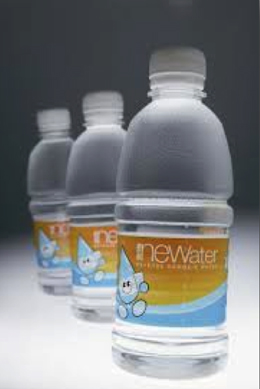 Water from waste water in Singapore
Water from waste water in Singapore
NEWater was also bottled in attractive packaging for public sampling.
Top government officials including the then Prime Minister of Singapore became NEWater ambassadors and champions when they were seen drinking NEWater publicly.
During the 2002 National Day Parade, some 60,000 Singaporeans toasted to the nation with NEWater.
To date, more than 25 million bottles have been distributed.
About PUB
PUB is a statutory board under the Ministry of the Environment and Water Resources. It is the water agency that manages Singapore’s water supply, water catchment and used water in an integrated way.
About PUB’s tagline: Water for All: Conserve, Value, Enjoy
PUB has ensured a diversified and sustainable supply of water for Singapore with the Four National Taps (local catchment water, imported water, NEWater, desalinated water).
To provide water for all, PUB calls on all to play our part to conserve water, keep our water catchments and waterways clean and build a relationship with water so we can enjoy our water resources. If we all play our part, we can have enough water for all our needs – for industry, for living, for life.
Find out more about PUB:
Visit our website at www.pub.gov.sg
Like us on Facebook at www.facebook.com/PUBsg
Follow us on Twitter at www.twitter.com/PUBsingapore
For our latest event photos, visit www.flickr.com/PUBsg or www.pinterest.com/PUBsg
Download our mobile app: MyWaters for iOS, Android or Windows Phone
See more at:
http://www.pub.gov.sg/mpublications/Pages/PressReleases.aspx#sthash.jGGVboGW.dpuf
http://www.pub.gov.sg/mpublications/Pages/PressReleases.aspx#sthash.jGGVboGW.dpuf
http://www.china.org.cn/world/Off_the_Wire/2014-03/21/content_31864930.htm
http://www.pub.gov.sg/water/Pages/singaporewaterstory.aspx#sthash.0uM7X7kJ.dpuf
This article was published on the Horizon International Solutions Site 23 March 2014, as the second article of the series Realizing Water, Sanitation and Hygiene for All published on the Solutions Site at www.solutions-site.org/node/1255.
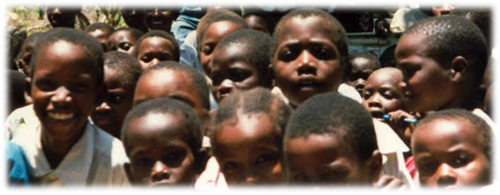 Happy children: Photograph by Jay Graham
Happy children: Photograph by Jay Graham
Positive Developments are covered in the next articles of this Series including coverage of the achievements of the WSSCC with its collaborators and of the Sulabh International Social Service Organization.
“Among the major gains in sanitation coverage have been made in northern Africa, southeastern Asia, and eastern Asia. Furthermore, open air defecation—the riskiest sanitation practice—is on the decline worldwide, with a global decrease from 25% in 1990 to 17% in 2008, equating to a decrease of 168 million people,” writes Jay Graham, Assistant Professor and Director of the MPH in Global Environmental Health at the George Washington University School of Public Health and Health Services in Horizon International's book, Water and Sanitation Related Diseases and the Environment: Challenges, Interventions, and Preventive Measures. This practice remains widespread, however, in southern Asia, where an estimated 44% of the population defecates in the open.
“More concerted culturally sensitive efforts, investments, creativity and persistence are needed for sanitation if we are to lay this most critical foundation of health and development.”
“Without WASH (water, sanitation and hygiene),
sustainable development is impossible,”
WHO/UNICEF Joint Monitoring Programme for Water Supply and Sanitation (JMP).
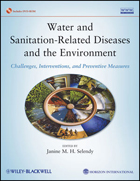 Book CoverThis article is presented as part of the Supplementary Material that accompanies the book Water and Sanitation Related Diseases and the Environment: Challenges, Interventions, and Preventive Measures, a Wiley-Blackwell publication in collaboration with Horizon International, written by 59 experts. Janine M. H. Selendy, Horizon International Founder, Chairman, President and Publisher, is Editor.
Book CoverThis article is presented as part of the Supplementary Material that accompanies the book Water and Sanitation Related Diseases and the Environment: Challenges, Interventions, and Preventive Measures, a Wiley-Blackwell publication in collaboration with Horizon International, written by 59 experts. Janine M. H. Selendy, Horizon International Founder, Chairman, President and Publisher, is Editor.
The book’s 4 hours of multimedia DVDs are included with an abundance of multidisciplinary resources, covering diverse topics from anthropology to economics to global health are being distributed free of charge by the Global Development And Environment Institute (GDAE) at Tufts University.
These are being given to thousands of libraries, organizations, and institutions in 138 less-wealthy countries. They are valuable additions to resources for use in classrooms and communities, by researchers and government decision-makers.
Map of countries
As of 30 January 2014, these resources have been made available in over 1,300 entities in 60 countries.
Read more: PDF Version is available at http://solutions-site.org/press/release1july2013.pdf
Search
Latest articles
Agriculture
- World Water Week: Healthy ecosystems essential to human health: from coronavirus to malnutrition Online session Wednesday 24 August 17:00-18:20
- World Water Week: Healthy ecosystems essential to human health: from coronavirus to malnutrition Online session Wednesday 24 August 17:00-18:20
Air Pollution
- "Water and Sanitation-Related Diseases and the Changing Environment: Challenges, Interventions, and Preventive Measures" Volume 2 Is Now Available
- Global Innovation Exchange Co-Created by Horizon International, USAID, Bill and Melinda Gates Foundation and Others
Biodiversity
- It is time for international mobilization against climate change
- World Water Week: Healthy ecosystems essential to human health: from coronavirus to malnutrition Online session Wednesday 24 August 17:00-18:20
Desertification
- World Water Week: Healthy ecosystems essential to human health: from coronavirus to malnutrition Online session Wednesday 24 August 17:00-18:20
- UN Food Systems Summit Receives Over 1,200 Ideas to Help Meet Sustainable Development Goals
Endangered Species
- Mangrove Action Project Collaborates to Restore and Preserve Mangrove Ecosystems
- Coral Research in Palau offers a “Glimmer of Hope”
Energy
- Global Innovation Exchange Co-Created by Horizon International, USAID, Bill and Melinda Gates Foundation and Others
- Wildlife Preservation in Southeast Nova Scotia
Exhibits
- Global Innovation Exchange Co-Created by Horizon International, USAID, Bill and Melinda Gates Foundation and Others
- Coral Reefs
Forests
- NASA Satellites Reveal Major Shifts in Global Freshwater Updated June 2020
- Global Innovation Exchange Co-Created by Horizon International, USAID, Bill and Melinda Gates Foundation and Others
Global Climate Change
- It is time for international mobilization against climate change
- It is time for international mobilization against climate change
Global Health
- World Water Week: Healthy ecosystems essential to human health: from coronavirus to malnutrition Online session Wednesday 24 August 17:00-18:20
- More than 400 schoolgirls, family and teachers rescued from Afghanistan by small coalition
Industry
- "Water and Sanitation-Related Diseases and the Changing Environment: Challenges, Interventions, and Preventive Measures" Volume 2 Is Now Available
- Global Innovation Exchange Co-Created by Horizon International, USAID, Bill and Melinda Gates Foundation and Others
Natural Disaster Relief
- STOP ATTACKS ON HEALTH CARE IN UKRAINE
- Global Innovation Exchange Co-Created by Horizon International, USAID, Bill and Melinda Gates Foundation and Others
News and Special Reports
- World Water Week: Healthy ecosystems essential to human health: from coronavirus to malnutrition Online session Wednesday 24 August 17:00-18:20
- STOP ATTACKS ON HEALTH CARE IN UKRAINE
Oceans, Coral Reefs
- World Water Week: Healthy ecosystems essential to human health: from coronavirus to malnutrition Online session Wednesday 24 August 17:00-18:20
- Mangrove Action Project Collaborates to Restore and Preserve Mangrove Ecosystems
Pollution
- Zakaria Ouedraogo of Burkina Faso Produces Film “Nzoue Fiyen: Water Not Drinkable”
- "Water and Sanitation-Related Diseases and the Changing Environment: Challenges, Interventions, and Preventive Measures" Volume 2 Is Now Available
Population
- "Water and Sanitation-Related Diseases and the Changing Environment: Challenges, Interventions, and Preventive Measures" Volume 2 Is Now Available
- "Water and Sanitation-Related Diseases and the Changing Environment: Challenges, Interventions, and Preventive Measures" Volume 2 Is Now Available
Public Health
- Honouring the visionary behind India’s sanitation revolution
- Honouring the visionary behind India’s sanitation revolution
Rivers
- World Water Week: Healthy ecosystems essential to human health: from coronavirus to malnutrition Online session Wednesday 24 August 17:00-18:20
- Mangrove Action Project Collaborates to Restore and Preserve Mangrove Ecosystems
Sanitation
- Honouring the visionary behind India’s sanitation revolution
- Honouring the visionary behind India’s sanitation revolution
Toxic Chemicals
- "Water and Sanitation-Related Diseases and the Changing Environment: Challenges, Interventions, and Preventive Measures" Volume 2 Is Now Available
- Actions to Prevent Polluted Drinking Water in the United States
Transportation
- "Water and Sanitation-Related Diseases and the Changing Environment: Challenges, Interventions, and Preventive Measures" Volume 2 Is Now Available
- Urbanization Provides Opportunities for Transition to a Green Economy, Says New Report
Waste Management
- Honouring the visionary behind India’s sanitation revolution
- Honouring the visionary behind India’s sanitation revolution
Water
- Honouring the visionary behind India’s sanitation revolution
- Honouring the visionary behind India’s sanitation revolution
Water and Sanitation
- Honouring the visionary behind India’s sanitation revolution
- Honouring the visionary behind India’s sanitation revolution

